Decorative heating radiators: not only warm, but also
The decoration of heating radiators, as well as the choice of models that have an attractive appearance, are fully justified. After all, you see, the appearance of a conventional battery cannot be called its advantage, so that when carrying out repairs, each of us seeks to either replace this part of the interior or disguise it so as not to spoil all the beauty.
Below we will tell you what to choose from and how to turn an old radiator into a design object.
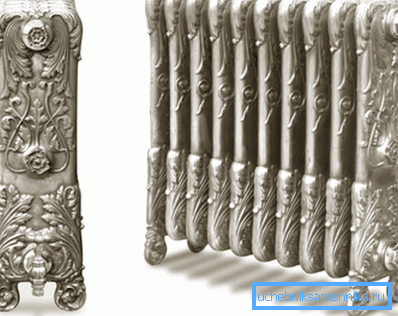
Battery design options
Unlike traditional cast iron "harmonicas" and steel converters from bent (even for a very short time) plates strung on a central tube, modern production models of heating radiators are produced in an entirely acceptable design. As a rule, their surface is covered with anti-corrosion paint of a light shade, and therefore such a product will look quite appropriate in almost any apartment or office.
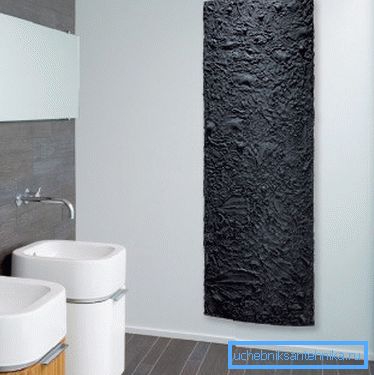
At the same time, sometimes you want to deviate from the standard, and therefore a certain part of the range of large manufacturers consists of decorative panels for radiators, as well as the batteries themselves, differing in their original appearance:
- Most often, manufacturers are experimenting with the shape of the heating elements.. Instead of the usual sectional design, the battery is made in the form of a monolithic panel or an elongated column. As a rule, such a product is placed not under the window, as is customary, but near a free wall.
Note! In this case, hidden pipelines with hot water will be optimal, since they can greatly degrade the overall impression.
- In addition, in some cases, the battery is styled either under a wall panel or an art object.. Naturally, the thermal performance will be significantly lower than that of the classical models, but usually these details do not care about the buyer.

- Finally, floor-standing and wall-mounted cast-iron radiators are becoming especially popular.. They are cast in special shapes, so that a floral or geometric pattern is formed on the surface. In this case, the loss of heat transfer will be minimal, since the internal structure of the radiator is fully preserved.
All decorative radiators have a common feature - the price, which is significantly higher than that of ordinary models. However, it was always necessary to pay for beauty.
Independent decoration
Painting and painting
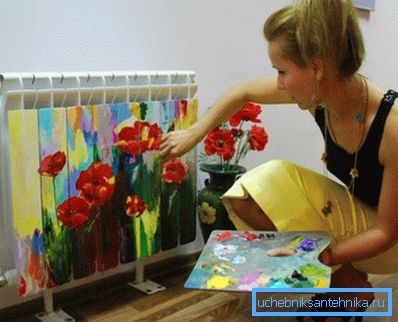
If you do not want to overpay for the design option, and look at the cast-iron construction on the wall is no longer mental strength - the battery is quite possible to decorate with your own hands.
The easiest way to do this is with paint:
- A special composition optimized for painting radiators is best suited for work. If you are planning to create some kind of drawing, then it is better to purchase several jars of small volume with different colors.
Note! Ordinary interior paint can also be used, but under the influence of high temperature, they quickly lose their brightness. More detailed information on the heat resistance of a pigment is usually contained in the instructions from the manufacturer.
- Before starting work, carefully clean the battery from the old paint. This can be done either with the help of a grinding machine with gritting, or with the help of a metal brush.
- Then we apply on the radiator a background layer that serves as the basis for our painting. For this purpose, suitable light shades that will not show through the pattern applied over them.
- When the base is dry, proceed to the painting of the radiator. To avoid mistakes, you can pre-make a sketch and transfer it to the product using the measuring grid.
This method of decoration is quite simple, but it allows you to drastically change the appearance of all heaters in your home, perfectly fitting them into the interior.

Masking by various designs
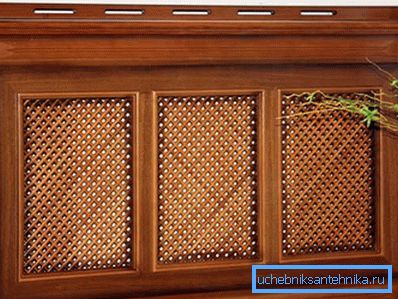
If you need to disguise a cast-iron, steel or aluminum radiator, and you don’t want to mess around with painting, it’s best to install a special screen on it:
- Decorative panels on radiators are usually fixed to the wall with special brackets. As a rule, they are installed in such a way that there is a gap of at least 50 mm between the surface of the panel and the metal of the heat exchanger.
- The front of the screen is usually made perforated: either a grille made of different materials or blinds is installed. Use solid screens can not, because it leads to a serious violation of the thermal characteristics of the room.
Note! The sill covering the top of the radiator should not be solid either. Usually, a hot air outlet is cut through the heater, which is covered with a decorative grille.
- The panel covering the radiator can be made independently. Usually the frame is made of MDF panels or solid wood treated with non-combustible composition.
- For the manufacture of blinds, it is better to take wooden strips, and the grille should be made either from perforated fiberboard or from thin plywood.
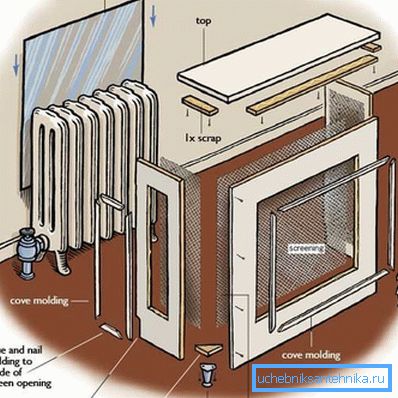
- Outside, the screen is carefully ground, ground and painted in a color corresponding to the style decision of the interior.
It should be noted that the installation of any structures that overlap the heating radiator impairs the quality of space heating. On the other hand, if you designed a system with a margin of power, then you can easily afford a small loss of heat for the sake of an attractive appearance.
Conclusion
Despite the fact that the decor of radiators does not in the best way affect their efficiency, it is not worth refusing. If you have the necessary knowledge, you can optimally combine performance and beauty, and the above tips, as well as a very informative video material, will help in this.